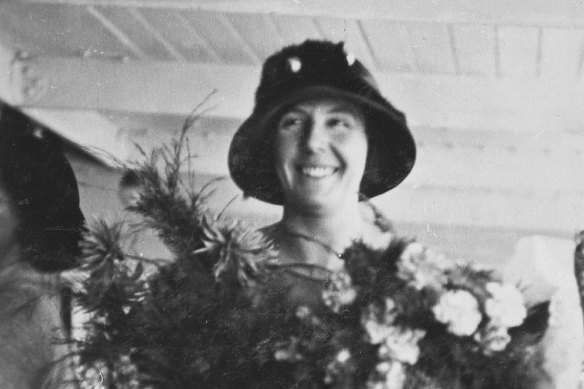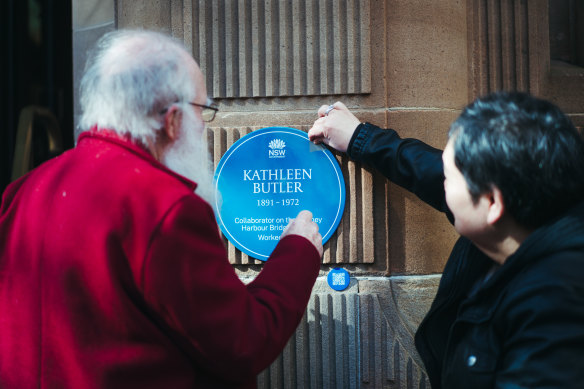By Julie Power
Miss Kathleen Butler was described as “that clever girl”, “Miss Efficiency” and the “godmother of the Sydney Harbour Bridge”.
But, despite doing the work of civil engineer and project manager from the age of 21, Butler was never described as one. Her formal title was confidential secretary to NSW’s most famous engineer, John Bradfield.
Her role in managing the £5 million project to build a bridge that, in 1932, joined Sydney’s north with south, was recognised on Tuesday with the unveiling of a NSW blue plaque outside the Chief Secretary’s Building on Phillip Street, in Sydney CBD, where Butler worked.

Kathleen Butler onboard SS Ormonde, 30 April 1924.Credit: Image courtesy Museums of History New South Wales – State Archive Collection
The plaque celebrates Butler’s enduring legacy as the Harbour Bridge’s de facto project manager, tender manager, negotiator and publicist, who forged a path for women in engineering and STEM.
Engineering Australia heritage committee member Bill Phippen, who campaigned for Butler’s recognition, said her title may have been confidential secretary, but her role was project manager, and she did the work of an engineer.
Butler was without parallel anywhere in the world at that time, except for another bridge builder, Emily Warren Roebling, commonly described as the “woman behind the man who built the Brooklyn Bridge” in the 1870s, he said.
Phippen said they were both “unqualified women doing heroic work as de facto civil engineers at a time when the profession was almost exclusively male”.
Yet Roebling was better known in New York than Butler’s work is in Sydney.
“They were unqualified women doing heroic work as de facto civil engineers when the profession was almost exclusively male.”
Engineering Australia heritage committee member Bill Phippen
Butler started at the Department of Public Works in Sydney in 1910, aged 19. When Bradfield was appointed as chief engineer of the Sydney Harbour and City Transit branch in the Department of Public Works, Butler was his first staff pick.
Butler was involved in every aspect of the construction of the bridge. Excelling at maths at school, she said in 1925 that she found “delight in specifications and calculations”.
About 100 years ago today, she was in England – sent by Bradfield – leading a team of young male engineers supervising in London office of Dorman Long, which had won the bridge contract.
By 1922, The Sunday Times wrote that Butler’s achievements were a rebuttal to anyone who thought women were the weaker sex.
“For those who thought women the intellectually inferior to man in brain possibilities, Miss Kathleen Butler, secretary and clerk to Mr J. J. C. Bradfield, the bridge designer, would put the argument all askew. Mr Bradfield is the father of the bridge, but Miss Butler is the godmother,” the piece read.
The newspaper quoted Mr A. E. Ellis, the manager of the Pittsburgh Testing Laboratory in the United States, who had studied Butler’s plans and specifications for the construction of the cantilever bridge across Sydney Harbour.

Engineers of Australia member Bill Phippen and Engineers of Australia Sydney president Olivia Mirza mark Kathleen Butler’s contribution to the creation of the Sydney Harbour Bridge.Credit: Dion Georgopoulos
It was a “more complete and comprehensive specification than any we have thus far encountered in our experience of inspecting large bridges”, he said.
Butler resigned from her job to marry in 1927, and was unable to continue work because of the ban on married women in the public service.
She died in 1972, aged 81.
Phippen admitted Butler would not have been allowed to work as an engineer today without formal qualifications.
“But who among us would not trade four years of study for 15 years of one-on-one tuition by John Bradfield?” he said.
Bradfield’s grandson, Jim Bradfield, said he was “particularly proud” that 112 years ago his grandfather had recognised that women can play as much a role as men.
Today, only 14 per cent of Australian engineers are female.
Engineers Australia Sydney president and Western Sydney University professor Olivia Mirza heralded Butler as a pioneer for women in engineering.
She said the organisation was working hard to increase the number of women engineers, and hoped Butler’s story would encourage more girls and women to see engineering as a potential profession.
The Morning Edition newsletter is our guide to the day’s most important and interesting stories, analysis and insights. Sign up here.